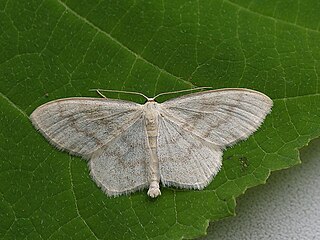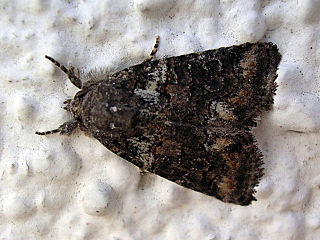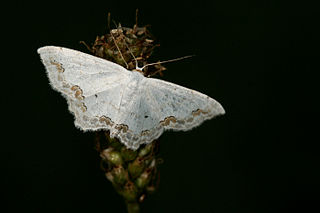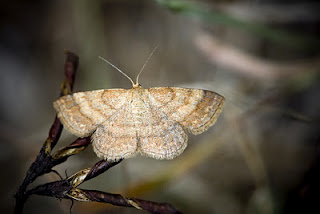
The cream wave is a moth of the family Geometridae. The species was first described by Adrian Hardy Haworth in 1809. It is found in forest and woodland regions, feeding on grasses and small plants such as dandelion.

Scopula immutata, the lesser cream wave, is a moth of the family Geometridae. It was described by Carl Linnaeus in his 1758 10th edition of Systema Naturae. It is found throughout Europe.

Bryophila is a genus of moths of the family Noctuidae. The genus was described by Treitschke in 1825.

Scopula is a genus of moths in the family Geometridae described by Franz von Paula Schrank in 1802.

Scopula ternata, the smoky wave, is a moth of the family Geometridae. It was described by Franz von Paula Schrank in 1802. It is mainly found in northern and parts of central Europe and in isolated populations in southern and south-eastern Europe. Its western range is eastern France, eastern Belgium and Scotland, with an isolated population in the Pyrenees. In the north its range extends to the polar regions and in the south it is found up to the Alps. Its eastern range extends through central and northern Russia up to the Ural, through Siberia up to the Yenisei River.

Scopulini is a tribe of the geometer moth family (Geometridae), with about 900 species in seven genera. The tribe was described by Philogène Auguste Joseph Duponchel in 1845.

Scopula ornata, the lace border, is a moth of the family Geometridae. The species was first described by Giovanni Antonio Scopoli in his 1763 Entomologia Carniolica. It is found in Europe, North Africa and the Near East.

Scopula turbidaria is a species of moth in the family Geometridae. It is found in France, Spain and Portugal. It is also found in North Africa.
Scopula asellaria is a moth of the family Geometridae. It was described by Gottlieb August Wilhelm Herrich-Schäffer in 1847. It is found in southern Europe and North Africa.
Scopula indicataria is a moth of the family Geometridae. It is found in China, Korea, Japan and Russia.
Scopula confinaria is a moth of the family Geometridae. It is found in southern Europe, southern Russia and Turkey.
Scopula coniaria is a moth of the family Geometridae. It was described by Prout in 1913. It is found in Japan and Russia.

Scopula corrivalaria is a moth of the family Geometridae. It is found from Japan, Korea, China and the Russian Far East through Siberia and Russia to western Europe. In Europe, it ranges from northern Central Europe to the Mediterranean. The habitat consists of marshes and wet meadows.
Scopula eurata is a moth of the family Geometridae. It was described by Prout in 1913. It is found in Turkmenistan.
Scopula flaccata is a moth of the family Geometridae. It is found in the Palestinian Territories, Israel, North Africa and has recently been recorded from southern Europe.
Scopula humifusaria is a moth of the family Geometridae. It is found in Russia, Turkey, Turkmenistan, Kyrghyzstan and Kazakhstan.
Scopula immistaria is a moth of the family Geometridae. It is found in Bulgaria, Ukraine and Russia.

Scopula submutata, the Mediterranean lace border, is a moth of the family Geometridae. It is found in southern Europe, North Africa and the Near East. The habitat consists of open, dry grassland and rocky slopes.
Scopula pratana is a moth of the family Geometridae. It is found in North Africa, the Canary Islands, the Near East and Yemen.
Gnophini is a tribe of moths.









